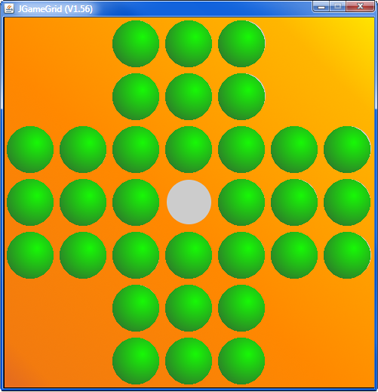GameGrid: Game programming with Java |
|
| Research project PHBern |
|
|
 |
Program code:
|
// BoardSolitaire.java import ch.aplu.jgamegrid.*; import java.awt.Point; import java.util.*; public class BoardSolitaire extends GameGrid implements GGMouseTouchListener { final int DOWN = 0; final int UP = 1; Actor draggedMarble; private ArrayList<Location> boardPatternLocations = new ArrayList<Location>(); private Location initialMarbleLocation; public BoardSolitaire() { super(7, 7, 70, null, "sprites/solitaire.png", false); setBgColor(255, 166, 0); setTitle("Solitaire"); loadMarbleLocations(); loadMarbles(); show(); setSimulationPeriod(20); doRun(); } public void act() { refresh(); } public void mouseTouched(Actor touchedMarble, GGMouse mouse, Point spot) { Location mouseLoc = toLocation(mouse.getX(), mouse.getY()); Point mousePoint = new Point(mouse.getX(), mouse.getY()); switch (mouse.getEvent()) { case GGMouse.lPress: //define draggedMarble: if (draggedMarble == null) { draggedMarble = touchedMarble; initialMarbleLocation = touchedMarble.getLocation(); draggedMarble.show(UP); draggedMarble.setOnTop(); } else { draggedMarble.show(DOWN); draggedMarble.setLocationOffset(new Point(0, 0)); draggedMarble.setLocation(initialMarbleLocation); draggedMarble = null; } break; case GGMouse.lDrag: if (draggedMarble != null) draggedMarble.setPixelLocation(mousePoint); break; case GGMouse.lRelease: if (draggedMarble != null) { draggedMarble.setLocationOffset(new Point(0, 0)); if (isValidJumpLocation(mouseLoc, initialMarbleLocation, true) && jumpedMarbleExists(mouseLoc, initialMarbleLocation)) { draggedMarble.setLocation(mouseLoc); Actor jumpedMarble = getJumpedMarble(mouseLoc, initialMarbleLocation); removeActor(jumpedMarble); } else { draggedMarble.setLocation(initialMarbleLocation); } draggedMarble.show(DOWN); draggedMarble = null; isGameOver(); } break; } } private boolean jumpedMarbleExists(Location loc, Location initialLoc) { return getJumpedMarble(loc, initialLoc) != null; } private Actor getJumpedMarble(Location loc, Location initialLoc) { Double jumpDirection = loc.getDirectionTo(initialLoc); Location overJumpedLoc = loc.getNeighbourLocation(jumpDirection); return getOneActorAt(overJumpedLoc, Marble.class); } private void loadMarbleLocations() { for (int y = 0; y < 7; y++) { if (y < 2 || y > 4) { for (int x = 2; x < 5; x++) boardPatternLocations.add(new Location(x, y)); } else { for (int x = 0; x < 7; x++) boardPatternLocations.add(new Location(x, y)); } } } // Initializes marbles on the board private void loadMarbles() { for (Location loc : boardPatternLocations) { Marble marble = new Marble(DOWN); marble.addMouseTouchListener(this, GGMouse.lPress | GGMouse.lDrag | GGMouse.lRelease); addActorNoRefresh(marble, loc); } this.removeActorsAt(new Location(3, 3)); //make hole in middle } // check if location is a valid jump location private boolean isValidJumpLocation(Location loc, Location previousLoc, boolean isDragged) { int expectedMarbleNr; if (isDragged) expectedMarbleNr = 1; else expectedMarbleNr = 0; ArrayList<Location> validJumpLocs = new ArrayList<Location>(); for (int possibleDir = 0; possibleDir < 360; possibleDir += 90) validJumpLocs.add(previousLoc.getAdjacentLocation(possibleDir, 2)); return (boardPatternLocations.contains(loc) && validJumpLocs.contains(loc) && getActorsAt(loc, Marble.class).size() == expectedMarbleNr); } private void isGameOver() { ArrayList<Actor> leftMarbles = getActors(Marble.class); // One left => you win if (leftMarbles.size() == 1) { addActor(new Actor("sprites/you_win.gif"), new Location(3, 3)); restart(); } else { //check if there are any valid moves left for (Actor a : leftMarbles) { if (hasOrthagonalJumpableNeighbours(a)) return; } //no more valid jumps possible => you lose! addActor(new Actor("sprites/gameover.gif"), new Location(3, 3)); restart(); } } private boolean hasOrthagonalJumpableNeighbours(Actor a) { Location marbleLoc = a.getLocation(); for (Location loc : marbleLoc.getNeighbourLocations(0.5)) { double locDir = marbleLoc.getDirectionTo(loc); Location jumpLoc = loc.getNeighbourLocation(locDir); if (getActorsAt(loc, Marble.class).size() != 0 && isValidJumpLocation(jumpLoc, marbleLoc, false)) return true; } return false; } // restart game private void restart() { delay(5000); removeAllActors(); loadMarbles(); } public static void main(String[] args) { new BoardSolitaire(); } } // ----------- class Marble ------------------------ class Marble extends Actor { public Marble(int imgID) { super("sprites/marble.png", 2); show(imgID); } } |
In this example, the stones do not have to be dragged. To move them, simply click the desired stone and then click the free cell it has to jump to. The program code of this variation is much easier to understand.
![]() Edit this example in the Online-Editor (BoardSolitaire2.java)
Edit this example in the Online-Editor (BoardSolitaire2.java)
![]() Download the program code (BoardSolitaire2.zip)
Download the program code (BoardSolitaire2.zip)